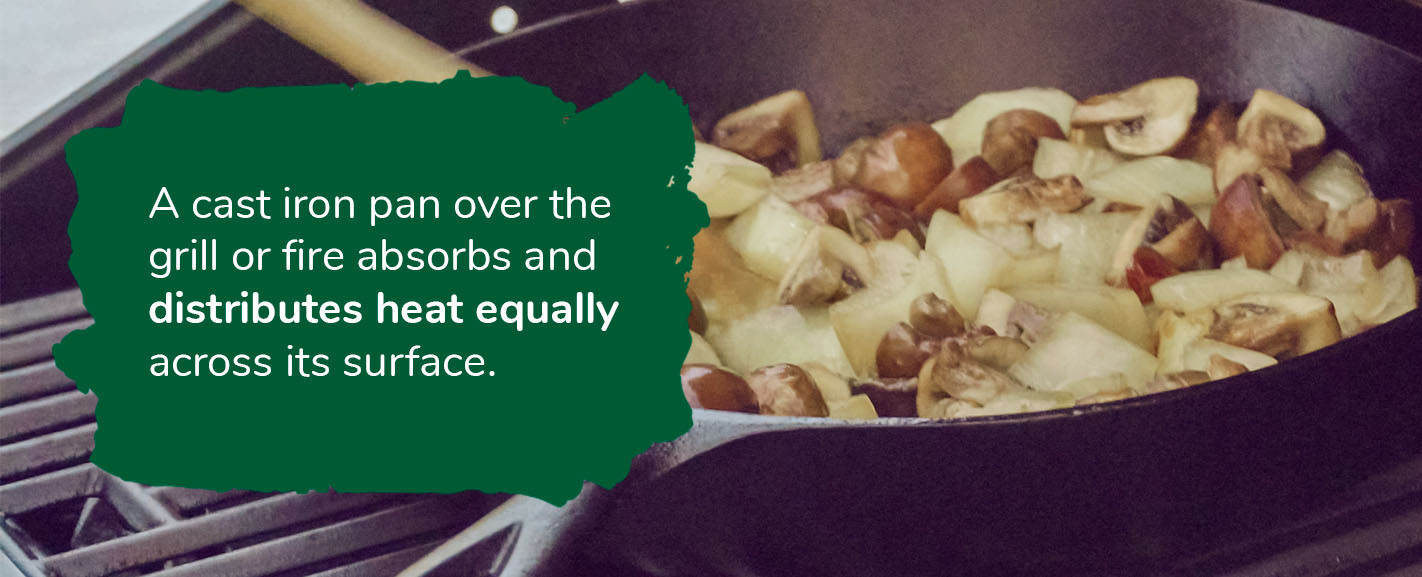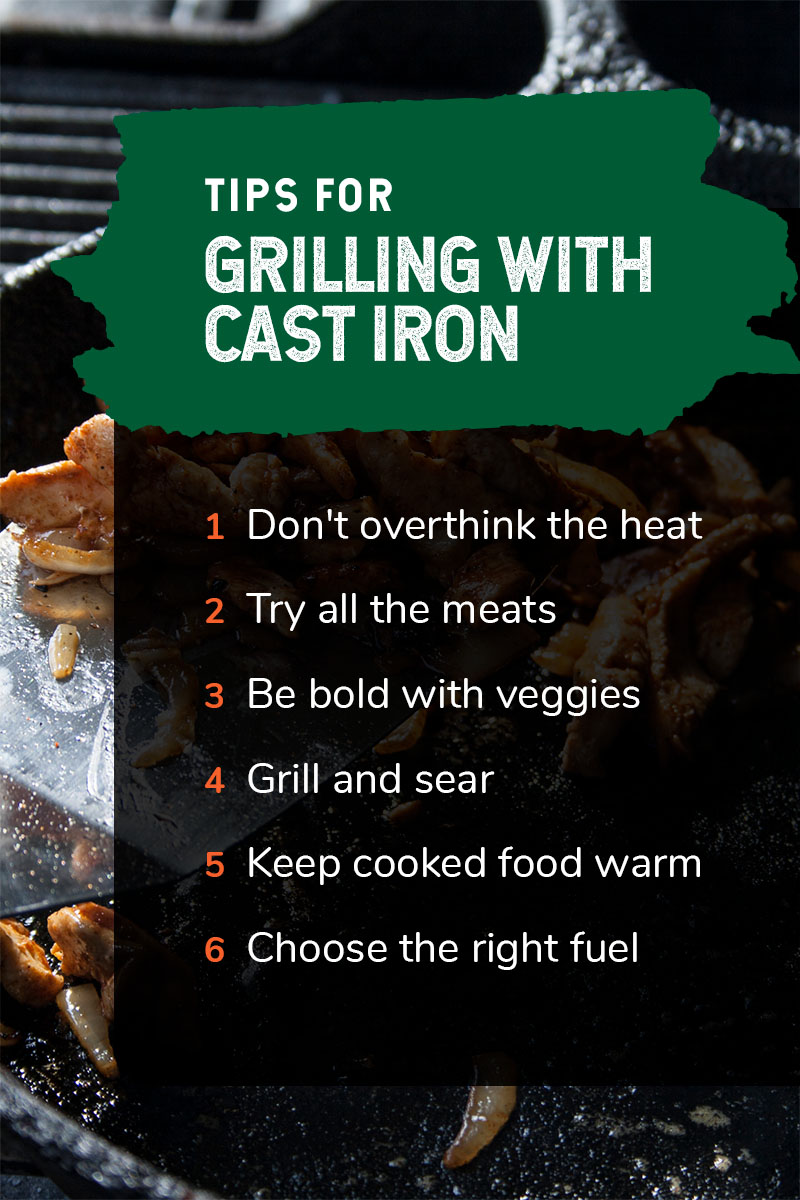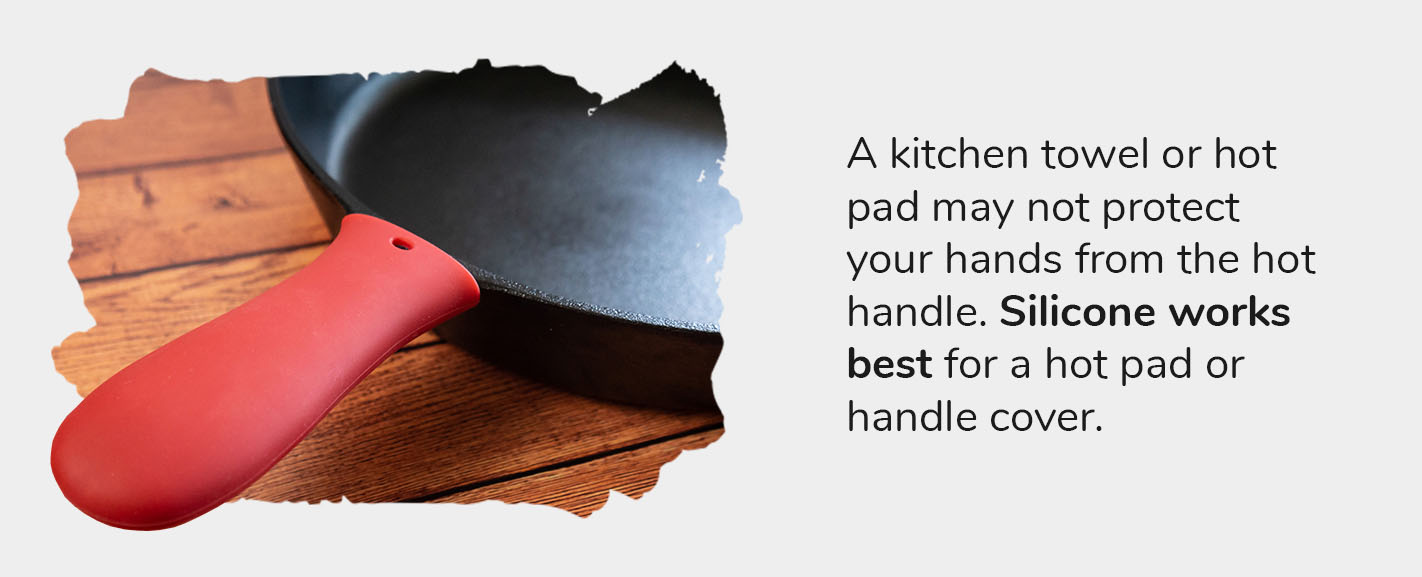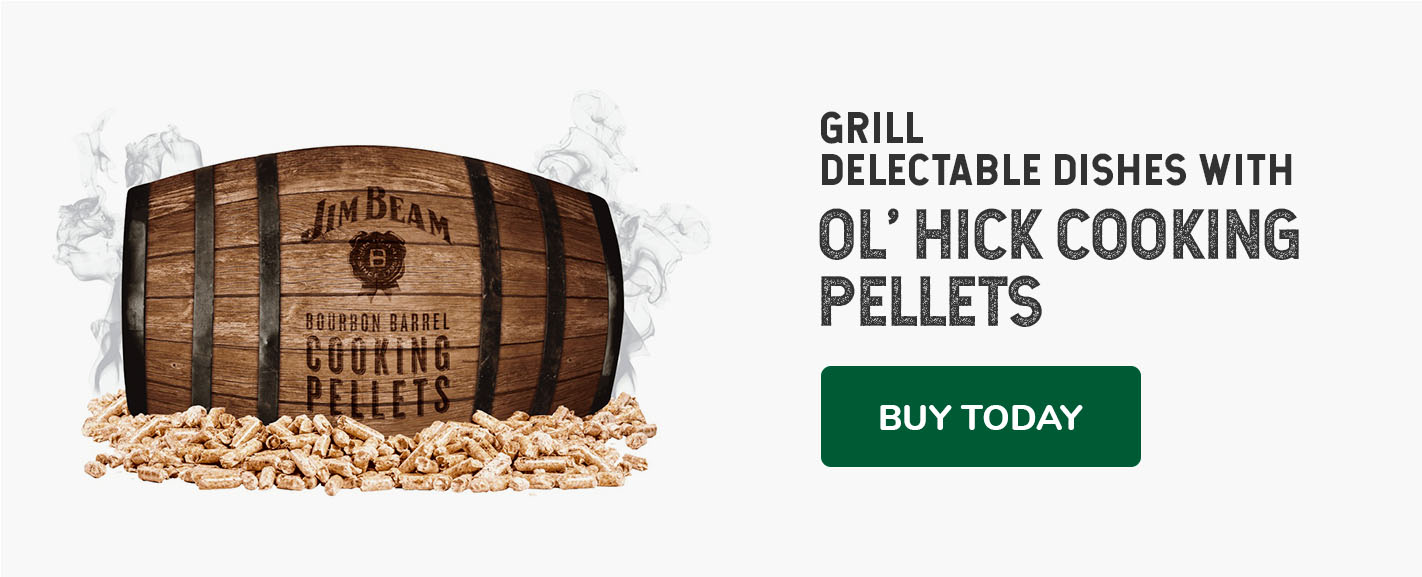Best Way to Grill With Cast Iron

The perfect way to enjoy the summer season is with a grill-out. With 70% of households in the United States owning a grill or smoker, grilling is a national pastime. As many grill enthusiasts know, grilling is an art that requires the perfect technique and the right tools.
When it comes to getting the perfect sear on the steak or crunch on the kebabs, a cast iron pan for grilling is the way to go. When you grill with a cast iron grilling skillet, you get a steady cook that can turn any backyard barbecue or campout dinner into a mouth-watering event. Grilling with cast iron opens the door for more grilling versatility, whether on the grill or over the open fire.
- Benefits of Grilling with a Cast Iron Skillet
- Ways to Grill with Cast Iron
- Tips for Grilling with Cast Iron
- Caring for Your Pan
- Grill Delectable Dishes with Ol’ Hick Cooking Pellets
Benefits of Grilling With a Cast Iron Skillet
From drying out meats to losing veggies into the grill, grilling comes with its share of challenges. Using your cast iron pan to grill can bring several advantages to your cookout. Here are a few of the benefits of using a cast iron pan with your grill:
1. Food Doesn’t Stick
If you’ve been grilling for very long, you’ve likely run into trouble with food sticking to the grates. Unless your grill grates are pristine, they might have charred bits of ash and leftover food. Cleaning the grates and keeping your grill well-oiled is essential for keeping your food in one piece.
However, using cast iron to grill on the fire pit or grill is often a better way to keep food from sticking. A cast iron skillet or griddle still requires regular cleaning, but this process is usually easier than the grates on your grill because cast iron is naturally non-stick. Cast iron is also ideal for delicate fish filets, shrimp and chicken that are more prone to sticking than fatty meats like beef. If your cast iron pan is well-seasoned, all you need is a drizzle of oil to keep the meat from sticking to the pan while you cook.
2. Versatility
Your cast iron pan may already be your favorite cooking tool in your kitchen because of its versatility. Cast iron pans work well with just about any food, from breakfast like pancakes and biscuits to steak dinners and desserts. That same flexible quality makes cast iron a winner on the grill. Using your cast iron pan with the grill expands your grilling repertoire by leaps and bounds, making you ready for any grilling occasion.
Although grilling on the grates works fine with hotdogs and skewers, cast iron makes it possible to cook any other dish that requires a sauce or fragile ingredient. Cast iron can put the perfect sear on any cut of meat, keeps smaller vegetables from falling in the grate and infuses burgers with more flavor by keeping all the juices in the pan.
3. Even Cooking Temperature

Uneven heat and sudden flare-ups can turn a juicy steak into a charred mess. Dripping hamburger grease can be to blame, although some grilling methods cook more evenly than others. Humidity changes, wind and cooking over charcoal or propane can make it more difficult to control your grill’s temperature.
A cast iron pan over the grill or fire provides an even cooking temperature by absorbing and distributing heat equally across its surface. Cast iron holds heat better than any other pan because of the thicker metal, making it easier to avoid flare-ups. With this grilling method, you heat your grill or start your campfire and let the cast iron skillet heat up. Even if your fire dies down, the pan will retain its heat for a long time.
Ways to Grill With Cast Iron
People prefer all different grilling methods, with some choosing to cook directly on their grill and others wanting the flexibility of a pan. Here are the two most common ways of grilling with cast iron:
1. Over the Fire
Using a cast iron pan may be the simplest way to grill over the fire. Cast iron pans come in the regular skillet variety, although you can also find a cast iron grill pan with a press at many major cast iron pan retailers. The pan provides flexibility, as you can use it with a wider variety of foods and different grilling methods than the standard grill.
For barbecues, cookouts and camping trips, a cast iron pan works well over a fire. To cook most recipes, set your pan over the fire or in the coals to heat the pan, then add some oil. Wait until the oil starts shimmering before adding your food.
2. Right on the Grill
Depending on your type of grill, you might also be able to barbecue with a cast iron grill without using a pan. Most grills come with standard metal grates, which can heat up unevenly as the heat source fluctuates. To avoid ending up with some food underdone, look for cast iron grates that can provide the benefits of cast iron without the pan.
You can find cast iron grates at most stores that sell grill replacement parts. Cats iron on gas grill grates are popular, as are pellet grills that use wood pellets to infuse food with a wood-smoke flavor.
Tips for Grilling With Cast Iron
As with all types of cooking, using your cast iron pan with the grill requires some skill and technique. With a few helpful reminders and some practice, you’ll be well on your way to serving up juicy grilled meats and the perfect sides using your cast iron pan. Here are a few of the best tips for grilling with a cast iron skillet:
1. Don’t Overthink the Heat
Whether you invested in a professional grill or have an affordable grocery store version, using a cast iron pan can help your food heat up evenly and quickly. You can cook with your grill on low or high heat since cast iron retains heat remarkably well once heated. If your grill has a built-in thermometer, you can heat it to the normal temperature for most recipes, whether you need to cook on medium or high.
Carefully monitor your grill’s temperature, especially as you experiment with the cast iron pan. Adjust the heat as needed to achieve your desired results, and watch for visual cues that tell you when the pan is good to go. You can also move your skillet away from the flame to continue cooking food on low heat.
2. Try All the Meats
Grilling with cast iron offers you the freedom to cook whatever you like. You might avoid putting flaky fish or tiny scallops directly on the grill, but with a cast iron pan, you can go all in with nearly any kind of meat — no skewers needed!
Cast iron skillets contain your food on the grill, so there’s no chance of losing half your Alaskan salmon filet to the grill below. If you’re grilling a recipe requiring sauce, the pan allows you to cook the sauce with the meat to make it more flavorful. Cast iron pans can do everything from getting the perfect crust on a steak to cooking a one-pan chicken dinner.
3. Be Bold With Veggies
Vegetables like cherry tomatoes and green beans are notorious for slipping through the grill grates. Any vegetable can drop out of place on your standard grill unless you have a skewer to steady them.
With a cast iron pan, you can grill even the tiniest veggies without fearing dropping them into your grill. Cast iron pans can also withstand extremely hot temperatures, so try charring the veggies for that stir-fry recipe. You might even get creative by grilling fruit like peaches, watermelon, pineapple and bananas.
4. Grill and Sear
Most cuts and types of meat, especially steak, burgers and pork chops, cook best on a combination of high and low heat. The high-heat sear creates a caramelized crust while cooking on low provides the desired doneness without overly drying the meat. With a cast iron pan, you can easily do both.
To sear meats on cast iron, start by warming the pan to the hottest temperature setting. Place meat in the pan for about one minute on each side, just enough to give it a crispy crust. After the sear, move the meat to an indirect grilling space on low heat. Reverse searing is when you do the high-heat step at the end.
5. Keep Cooked Food Warm
Although you should always be careful when leaving cooked foods on cast iron, as the pan can continue cooking and dry food out, you can also use the cookware to keep foods warm while preparing the rest of your meal.
Place a cast iron pan at the edge of your grill in the indirect cooking area to avoid drying out the food. The pan should be as far away from the heat as possible while still keeping the pan warm. This technique helps hold your food at the right temperature while you cook sides or finish the last round of burgers.
6. Choose the Right Fuel
Choosing the right cooking fuel can make a significant difference when grilling with cast iron. Two of the most popular grilling fuels are charcoal and propane, which have several disadvantages compared to other fuel types. Both of these fuels can introduce unpleasant flavors and are inconvenient to use.
Using BBQ cooking pellets for grilling meats and vegetables can give them a smoky barbecue flavor that complements your other spices and seasonings. These pellets also burn more consistently than charcoal and help you control the temperature better than on a propane grill.
Caring for Your Pan
Cast iron requires more care than other cookware, but the reward is worth the effort. With careful and consistent maintenance, your cast iron skillet can last for a lifetime and much longer. Consider these safety and care tips for keeping your cast iron pan in top shape:
1. Clean Thoroughly
After each grilling with a cast iron pan, cleaning the pan is essential so your current dish doesn’t flavor the next one. For light messes, rinse the pan with hot water while it is still warm. Scrub food particles with a stiff brush and dry the pan with a paper towel. Any black residue that comes off on the towel is normal.
Heavier messes will require a few additional steps. Scrub away any leftover food before washing with a small amount of regular dish soap and hot water. Stuck-on food will usually come off if you simmer water in the pan for a few minutes and scrape with a brush. Remember never to submerge or leave cast iron pans wet for a while, as rust will likely form.
2. Season Well
Seasoning is a crucial step to maintaining your cast iron pan’s finish. This process involves creating a layer of carbonized oil on your pan’s surface. Thorough seasoning prevents rust from forming on your cast iron and promotes its non-stick quality. Seasoning also maintains the cast iron’s trademark black finish.
Each time you grill with oil, you add to your pan’s seasoning. However, using this technique after every wash will help keep a cast iron skillet in top condition. Well-preserved cast iron skillets should appear shiny, though not oily.
To season your cast iron pan, follow these steps:
- Clean your pan with warm soapy water.
- Dry thoroughly.
- Apply a thin layer of cooking oil like vegetable or canola oil to the pan’s entire surface.
- Place the pan upside down on the oven’s top rack and set a tray on the bottom shelf to catch any oil.
- Bake for an hour at 450 to 500 degrees Fahrenheit.
- Let the pan cool.
3. Beware Hot Cast Iron

In high-temperature grilling, the oils in your cast iron pan can expose the bare metal. Exposed, dry patches on the cast iron might turn up after a while, particularly on the bottom and edges of the pan. When your pan has cooled off, check for these areas and rub them with additional oil.
Always handle cast iron skillets with care. A kitchen towel or hot pad may not protect your hands from the hot handle. Silicone works best, so look for a hot pad or handle cover with that material.
4. Banish Rust
Even if rust sneaks onto your cast iron pan, you can still remove it with a few simple steps:
- Scour the pan with steel wool to remove the rust.
- Wash the skillet with warm soapy water.
- Rub a thin layer of oil into the entire pan.
- Place the pan in the oven on the top rack with a tray on the bottom for catching oil.
- Bake at 450 to 500 degrees Fahrenheit for one hour.
- Allow the pan to cool.
- Repeat as often as necessary to restore the pan’s finish.
Grill Delectable Dishes With Ol’ Hick Cooking Pellets
Cast iron pans are an ideal choice for increasing your grill’s versatility. With the right tools and fuel for your grill, the grilling opportunities are endless.
If you have a pellet grill, enjoy the natural flavors of Ol’ Hick Jim Beam BBQ pellets from Energex. These cooking pellets are made from Jim Beam bourbon barrels and infuse a smooth finish into any grilled food. Ol’ Hick Jim Beam BBQ pellets are a versatile grill fuel and are especially delicious with seafood, meats and vegetables.
At Energex, we select the highest quality materials to make our cooking pellets and follow a strict internal testing process to ensure we give our customers the best. Learn more about our Ol’ Hick BBQ pellets and how they can make your next grill-out spectacular.


